Have you ever spilled wine on your clothes and worried they’d be ruined forever? Well, worry no more, as today, we’ll show you how to remove even the toughest of wine stains.
The Science of Wine Stains
During the maceration phase of wine fermentation, grape skins transfer their color into the naturally clear juice. Red skins make the juices red, creating red wine. White wines are either made from grapes with light skins or, as in the case of champagne, the skins are removed after pressing the juices, and partial soaking creates rosé.
The red in wine consists primarily of anthocyanin, which, interestingly enough, is water soluble, meaning that it washes out fairly easily. The staining, meanwhile, is caused by another ingredient in wines called tannins. They are biomolecules that impart a unique flavor profile into wine, but because they bond to other molecules, they also stick the colored pigments in wine into your fabrics.
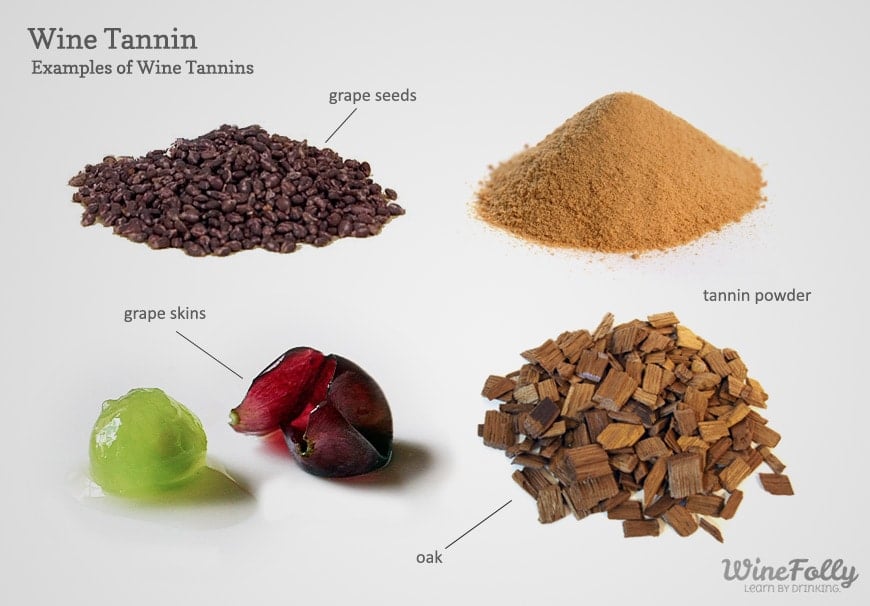
The stain-busting solutions we’re discussing today target tannins, so they should remove stains caused by all wine types, and they should also remove stains caused by similar beverages, including brandies like cognac or Armagnac and grappa.
You might assume that if a wine is clear, it won’t stain, but while the stain won’t be as immediately noticeable, it will still be there, so you’ll need to clean it to prevent it from attracting grime or reacting negatively with your clothing.
How to Remove Stains from Any Garment
Pretreating a Wine Stain
Unfortunately, you’re most likely to suffer a wine stain during moments like a reception or a party when you can’t simply drop everything and run to the laundry room. Taking a few discreet steps at the moment, however, will make the eventual full clean-up much easier without ruining the party.
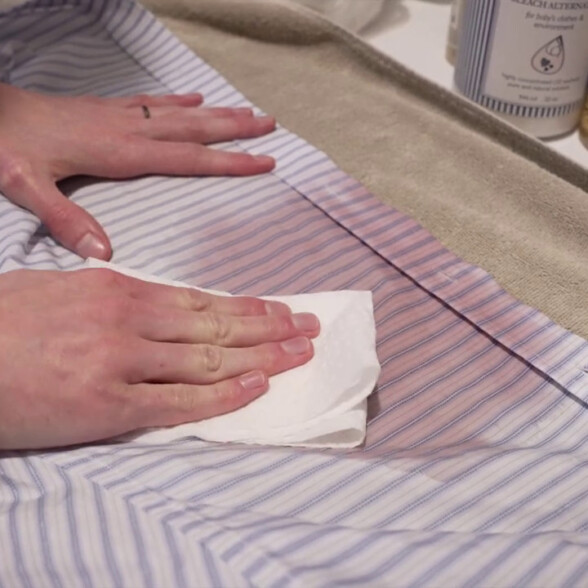
Before It Sets
Blot It Out
If you notice a wine stain, excuse yourself and go to the restroom or at least somewhere private. If the stain is on one of your principal garments, like a shirt, start by blotting at the stain with a dry paper towel to remove the excess wine. Don’t rub, however, as this might potentially set the stain further.
This might be all you’re able to do at the moment, but if you’re able to remove the garment, then run tepid or cold water through it from the backside to flush the stain out; and if the stain is prominent, consider using club soda or, ironically enough, white wine to flush the stain out further. This is because the minerals in the club soda and the pigments in the white wine can help dilute the red color and make it less noticeable. Then, dry the garment as much as possible, again by gently blotting, and return to your party.
Meanwhile, if the stain is on an accessory like neckwear or a pocket square, ask your host for some table salt or, better yet, kosher salt or sea salt, or get it yourself if you’re at home. Layer the salt on the stain to draw out the wine and its tannins. The salt start turning pink. Check on the stain every hour or so, replacing the salt as necessary, and when the salt stops turning pink, repeat the steps that we’ve already mentioned; if you happen to have a spare shirt handy, say if you’re at home or you’ve got a spare shirt in the car, you can also use the salt technique on a shirt.
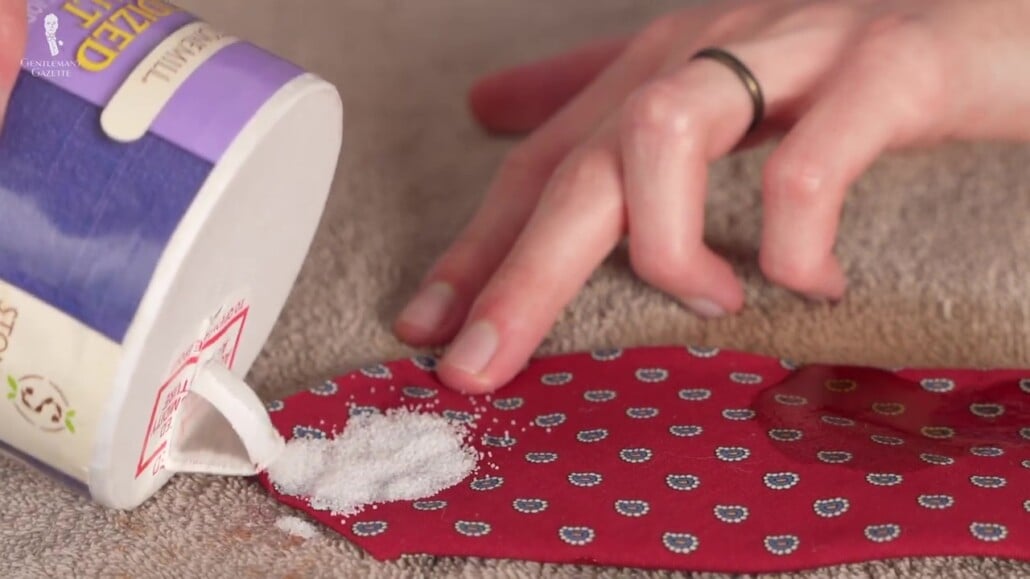
Remember, though, to avoid the temptation to scrub at the stain as you might spread it, and be wary of what you use to clean it with. Using bar soap, for instance, could actually make the stain worse. This is because the fatty soap molecules will absorb the wine pigments and then attach themselves to the fibers of your clothing.
At this point, you’ve basically done all that you can do without abandoning the party. So, enjoy yourself, forget about the stain, and try not to stain anything else.
How to Remove Wine Stains
Washable or Spot-Clean Fabrics
The following steps are for washable fabrics or minor stains that can be spot-cleaned. Meanwhile, for serious wine stains on delicate, specialty, or dry-clean-only fabrics, you can jump ahead; and as always, if you’re concerned about any cleaning process ruining a garment that you have, start by testing an area of the garment that isn’t normally visible.
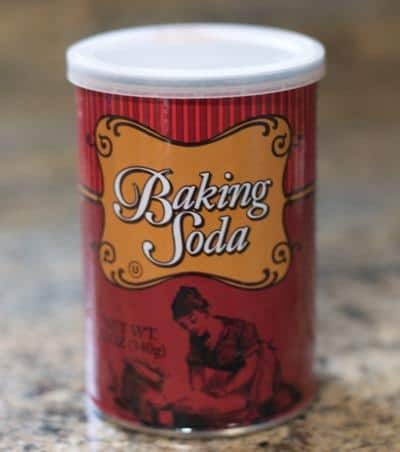
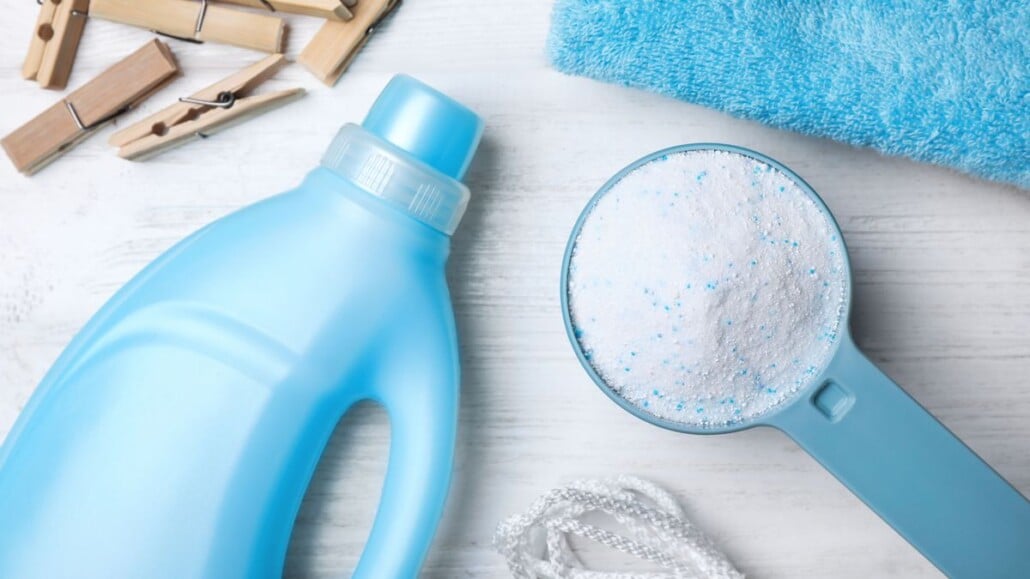
First, layer baking soda over the stain to see if it draws out any wine. If it does turn pink, keep repeating this process until the baking soda stops turning pink. Then, find a cleanser. Most laundry detergent is designed to target organic stains, including tannins, so apply a drop or dusting of detergent to the stain to cover it completely, then activate it using the hottest water that is safe for the garment, checking the tag for care instructions.
Then, with a soft brush or a sponge, gently dab the treatment into the fabric. Continue dabbing until the stain begins to disappear or liquefy. If appropriate, you can also soak the garment in a cleaning solution for several hours. Rinse with cold water, then dab dry with paper towels or a clean cloth or towel.
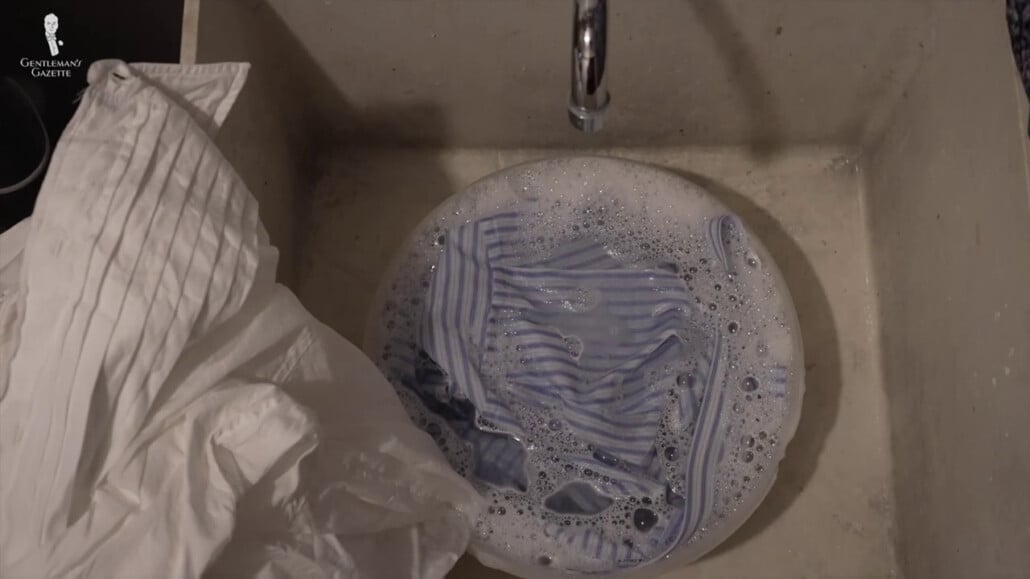
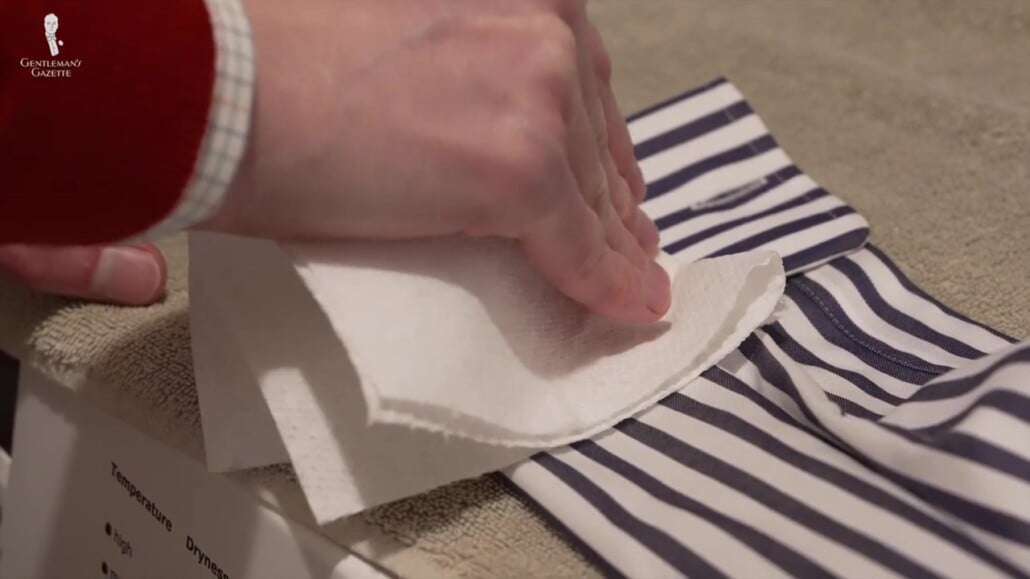
Repeat this process until you’ve successfully removed the stain; then, you can put the garment in the washing machine as normal. But don’t put it in the dryer until you’re sure the stain is gone, as the heat from the dryer can set the stain.
Stain-targeting Detergents
If the stain persists, consider using a stain-targeting detergent like the Laundress Stain Solution, Presto! Biobased, Arm and Hammer Plus Oxyclean, or Dirty Labs Detergent, or you can use a product specifically formulated for wine stains like Chateau Spill Wine Remover or Gonzo Wine Out, and as always, these products are merely suggestions.
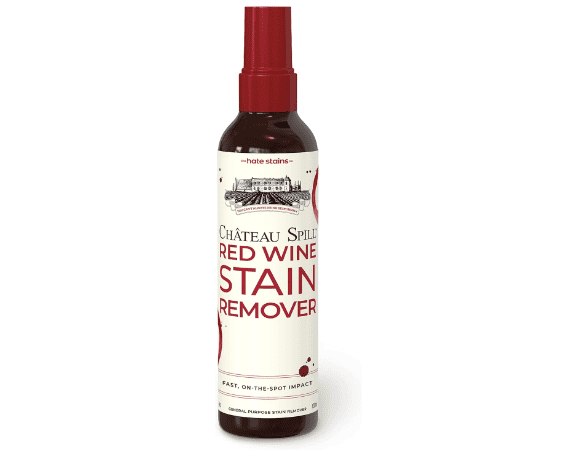
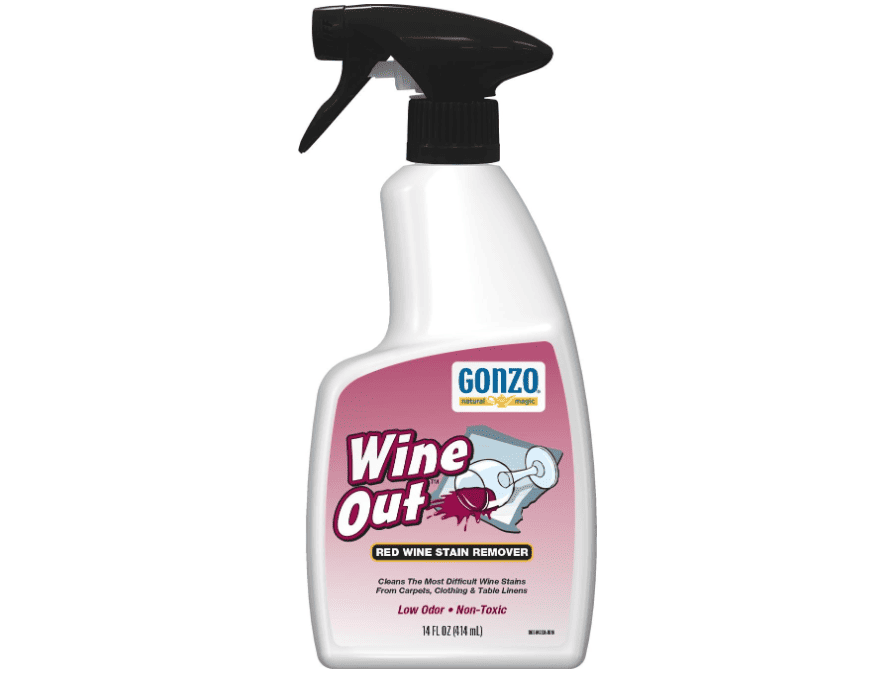
Use all of these products according to their labeled instructions, and take note of warnings about appropriate fabric types.
Household Solution
If your regular clothing detergent doesn’t seem to be cutting it and you don’t have any specialty products on hand, then you can replicate their stain-fighting power using a household solution. It probably won’t be as effective as a dedicated stain remover, but it should help.
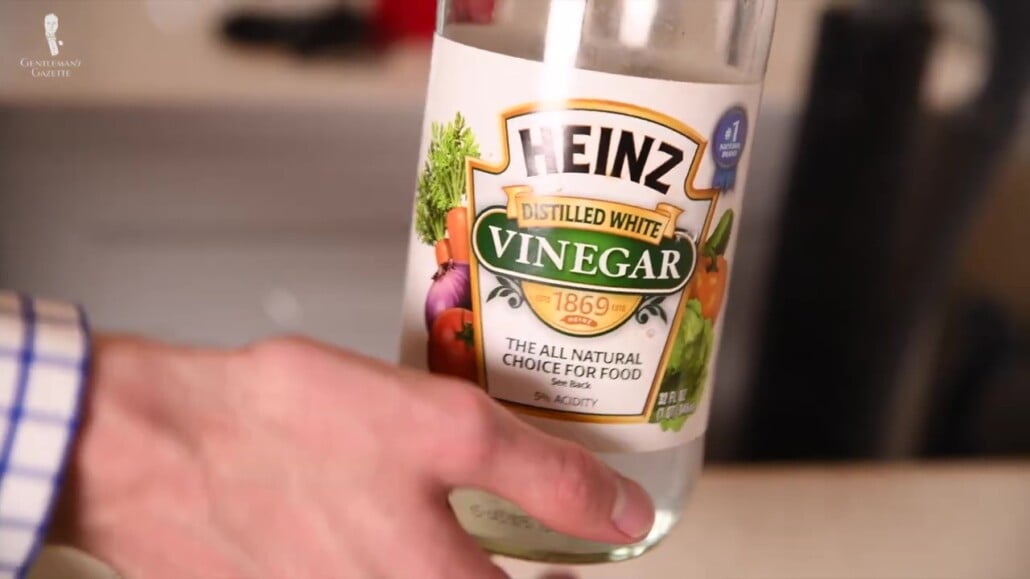
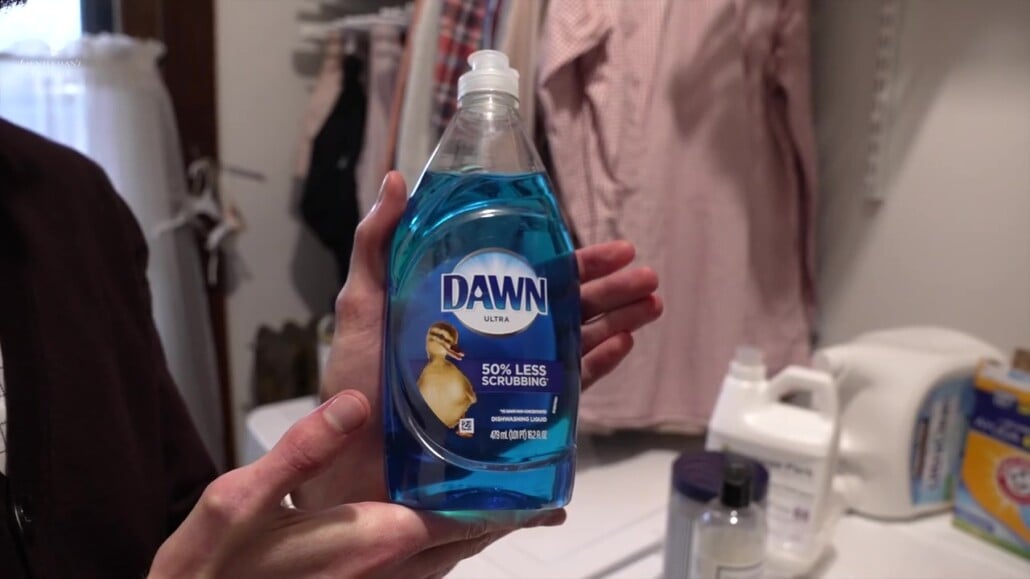
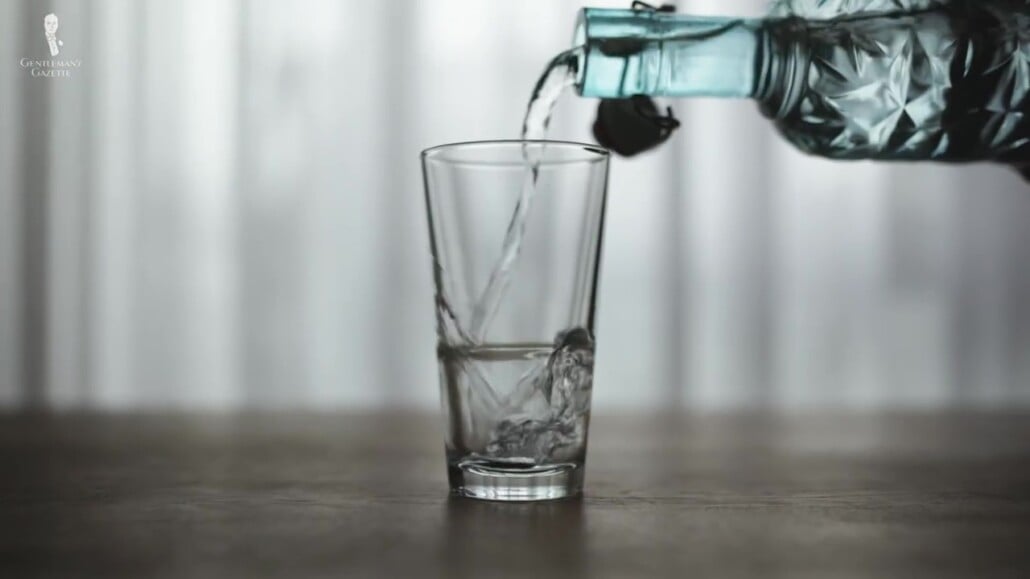
Combine one tablespoon of white vinegar, one tablespoon of dish soap, and 2 cups of water; and if the stained fabric in question is white, you can substitute the vinegar with half a cup of hydrogen peroxide.
This will function somewhat like bleach, however, so it should be used carefully and not with any colored fabrics. Apply this solution using the same steps as for the detergents we mentioned above.
Here’s the Secret to Keeping Your White Shirts…White!
Delicate and Speciality Fabrics
Knitwear
First up, for knitwear, create a solution of cool water and a mild detergent, apply it to the stain, and let it sit for a few minutes.
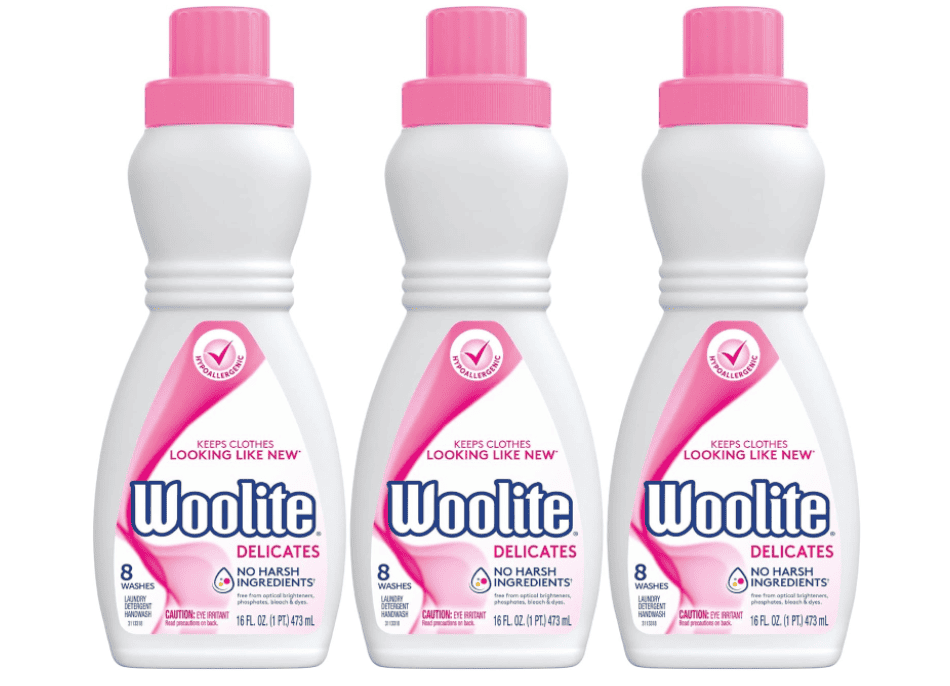
Next, soak the entire garment in a solution of tepid water and Woolite or a comparable detergent. Finally, hand wash the entire garment and then let it air dry. For more care tips of this type, you can consult our full guide to wool sweater maintenance.
Silks
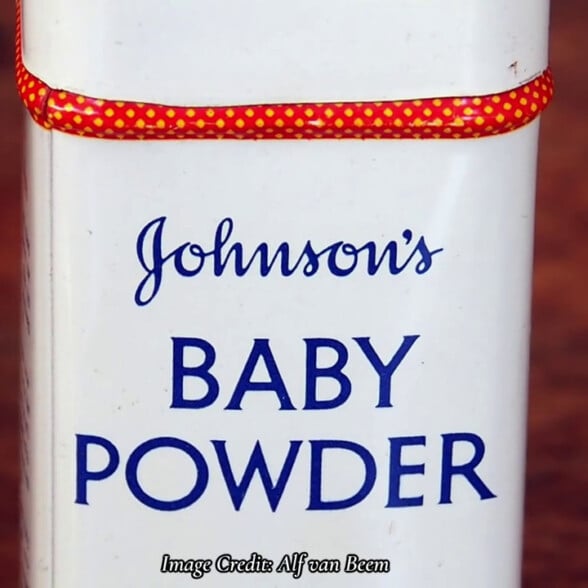
Instead of Salt
Use Baby Powder
For silks and comparable delicate fabrics, apply baby powder or talcum powder to the stain and replace it as needed, as you did with the salt.
Then, fully clear away the powder and hand wash the garment with a detergent formulated for delicates like Studio by Tide, The Laundress Delicate Wash, or Heritage Park Detergent. Then, allow the garment to air dry and repeat this process as needed.
Leather & Suede
For leather and suede, you can follow essentially the same process as for silks and delicates, replacing the detergent, however, with a dedicated leather or suede cleaner. Of course, follow the listed instructions on your product of choice.
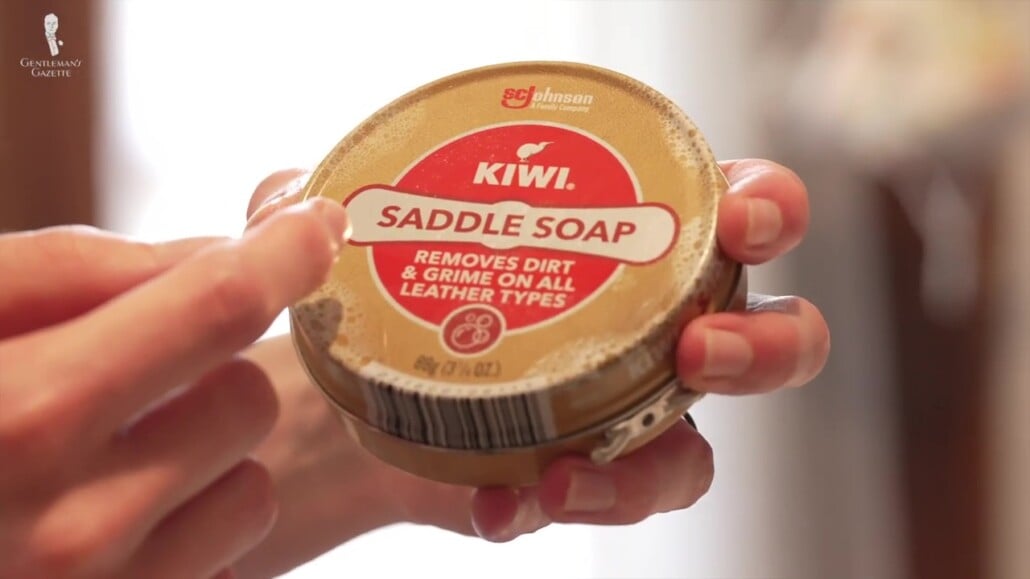
Dry Clean Only
Any garment that is labeled “dry clean only” should go to the dry cleaners, but if you’d like to be a bit more adventurous and try it yourself, you can find our guide to washing suits at home.
How To Wash a Suit at Home
Old Wine Stains
If you get to a wine stain before it dries completely (usually within the first 24 hours or so), then you should have good luck getting it out. But, if you’ve found an old stain or are dealing with one that is persisting, then follow these tips.
First, cover the stain with a cleaner that is appropriate to the fabric type, then submerge the garment in question in cold water. If the fabric is spot-clean only meanwhile, then you can simply soak the affected area with cold water.
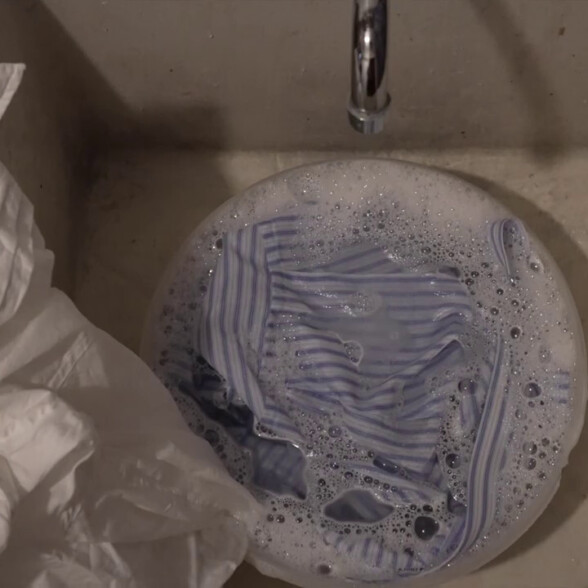
Reactivate The Stain
Soak In Water
After covering the stain with a cleaner, submerge or soak for at least 30 minutes, but ideally, you should leave the garment this way overnight to let the soaking take even more effect. Essentially, this process is intended to reactivate the stain so it can be removed from the fabric more easily.
Next, apply a dedicated or wine-targeting stain remover, following both its instructions and those on the tags of your garment. Then, wash the garment as usual, keeping in mind that you may need to repeat this process several times. If this is the case, it’s a good idea to take a picture of the stain after each washing so that you can tell whether you’re making progress or not.
Professional Help
Finally, if your stain refuses to budge, it’s probably time to call in professional help. So, if you determine that you can’t get the stain out yourself, you should try to get your garment to the dry cleaners as soon as possible so that the stain has less opportunity to set further.
Conclusion
They may be strong, the stains from wine and rosé, but if you’re earnest, you can get out even the toughest stains.
Let us know in the comments if there are any wine-washing or tannin-targeting tips we might have missed today!
Wine Stains FAQs
Are garments stained with wine ruined?
No, they are not! With a little effort and the proper tools, almost any stain can be removed or at least greatly reduced.
Why are wine stains so difficult to remove?
Wines, especially red wines, are rich in a molecule called “tannins.” These tannins are very sticky, and they cause pigments in the wine to adhere to other molecules, like the molecules in clothing fabrics or on your teeth. Cleansers that target these tannins will have the best luck removing wine stains.
What’s the best way to remove a wine stain?
To ensure success when dealing with a wine stain, it is essential that you pretreat the stain as quickly as possible. Dabbing away excess wine and ensuring that as little wine as possible settles into the fabric will make the final stain much easier to remove, no matter which methodology you employ.
Do you remove red wine stains differently from white wine or effervescents?
Red wine stains appear more noticeable than other wine stains because of the colored pigments in the wine. All wine stains, however, are due largely to tannins, which are present in all wines. Therefore, any process that works for removing red wine will work for all other wines.
How do you get out dried wine stains?
The first step to removing a dried wine stain is to moisten it again so that the stain “reactivates.” This will separate the stain from the fabric so that you can then clean it up. This guide has a dedicated section on exactly how to remove old wine stains.
What do I do if I get red wine spills on my carpet, upholstery, or couches?
The steps outlined in this guide will work on most fabric types, including the materials used in most home goods and furniture.
Does white wine really clean red wine?
White wine does not “clean” red wine. It does, however, dilute and partially obscure red wine, meaning that it can make a stain appear less obvious. Covering a red wine stain with white wine may make the stain less noticeable, but you will still need to clean the stain eventually.
Outfit Rundown
Today, I’m wearing a casual outfit, good for doing some garment care around the house and also appropriate for the relatively warm early December we’re currently experiencing at the time of production.
The central element, of course, is my cardigan sweater from Charles Tyrwhitt, appropriately enough in a burgundy color they call “wine.” I’m wearing it over a French-cuffed shirt also from Charles Tyrwhitt, featuring a magenta and blue-checked pattern over a white ground. The shirt has French cuffs, but I’m wearing them configured in a barrel style today with simple black links to fit more easily under the sweater sleeves.
My trousers are plain navy blue to harmonize with one of the accent colors in the shirt, and in the outdoor footage you’re seeing, I’m also wearing one of my flat caps. This one is from the Polish brand Poszetka. It features a houndstooth pattern in blue and off-white tones.
To continue the casual feel of today’s outfit, I’ve also left product out of my hair and let my beard grow further. Let me know in the comments if you like this look on me.
My shoes are dark oxblood penny loafers from Allen Edmonds, also in a similar wine sort of color, and my socks are two-tone solids from Fort Belvedere in burgundy and white.
Finally, for my fragrance today, I’ve gone for Quatro Rosso or Four Rosso from the Roberto Ugolini collection. It has a warm yet floral character that’s good for this time of year, and of course, the red tones of the bottle harmonize with my outfit.
So, for the socks I’m wearing today, as well as fragrances from the Roberto Ugolini collection and a wide array of other classic men’s accessories, you can take a look at the Fort Belvedere shop.


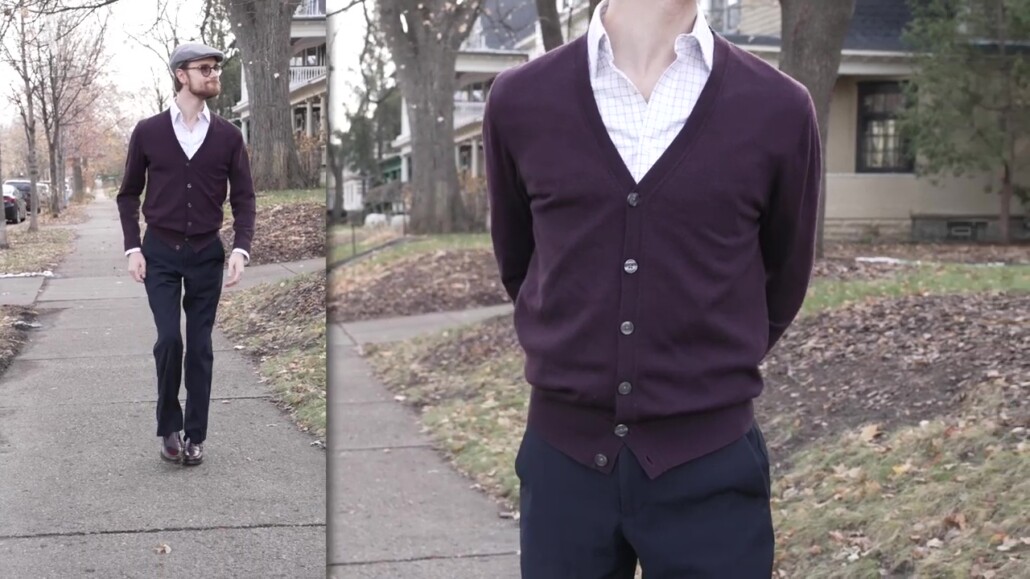
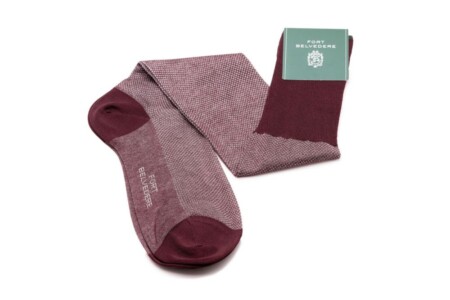
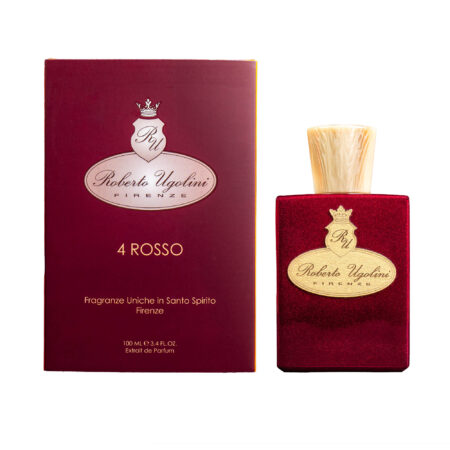
A brilliant idea which should be worked into a series – moving through the menu: soup stains, gravy stains, custard stains
And also stains on your reputation.
I go to Grandma’s Secret Stain Remover for almost all my stains. It’s the best thing I’ve found. (totally non sponsored!)
I’ll admit to being partial to facial hair but I think your beard looks quite sharp.
Wine Away is another excellent product to remove wine. It also has the capability of removing blood stains, Its instructions are straightforward on the package so I won’t repeat them here, but suffice it to say I treated a rather large blood stain on a pillow, then washed it, and there was no trace.
Really useful video, will save for any ocasion I might need it. It is not a stain, but I would like to know if the vodka trick can be used to remove musty odour from a silk tie?
Thank you very much.